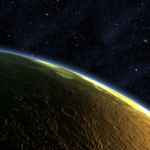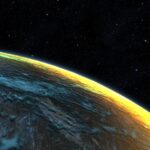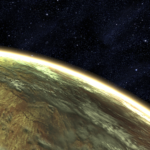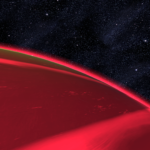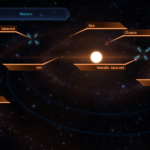System Specs:
- Stellar Mass: N/A Sol Masses
- Stellar Class: N/A
- Luminosity: N/A Sol
- Planets: 5
- Moons: >120
- Asteroid Belts: 2
- Asteroids: 2
- Objects: 0
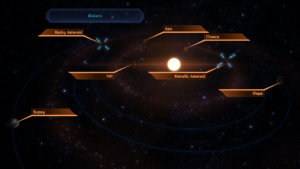
It is probably named for Lake Matano. All of the planets in this system are named after various deities of Inca mythology.
–
Planets Directory:
- Inti
- Chasca
- asteroid belt
- Apo
- Illapa
- asteroid belt
- Supay
–
Inti:
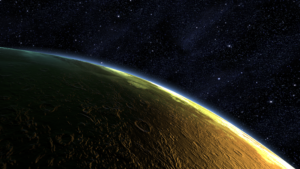
- Orbital Distance: N/A AU
- Orbital Period: 0.6 Earth-years
- Keplerian Ratio: N/A
- Radius: 9,032 km
- Day Length: 0.6 Earth-years
- Atmospheric Pressure: 0.56 atm
- Surface Temp: 157 °C
- Surface Gravity: 0.99 g
- Mass: 1.971 Earth-masses
Inti is a terrestrial planet with an atmosphere composed of ammonia and helium. Its surface is mainly composed of sodium oxide with deposits of magnesium. Its density is rather low, leaving the planet tide-locked to Matano.
Inti is an unremarkable world, drawing little more than a cursory scan for surface pirate anchorages when Alliance patrols enter the system.
–
Chasca:
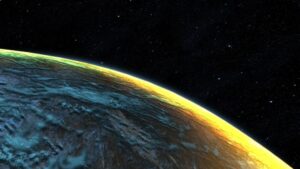
- Orbital Distance: N/A AU
- Orbital Period: 1.3 Earth-years
- Keplerian Ratio: N/A
- Radius: 8,059 km
- Day Length: 1.3 Earth-hours
- Atmospheric Pressure: 0.86 atm
- Surface Temp: 67 °C
- Surface Gravity: 0.88 g
- Mass: 1.395 Earth-masses
- Colony: human, no capital, founded 2183, population 150
Chasca is a large but low density world, fundamentally similar to its inner neighbor Inti. Like Inti, Chasca is tidally-locked to Matano. The same side always faces the sun, resulting in a scorching day side and a frozen night side. In the temperate areas around the terminator, temperatures average around 30 Celcius. Combined with a nitrogen-oxygen atmosphere, this slender band of habitable terrain allows limited colonization by humans.
Chasca’s ring is unique. It appears to be, for lack of a better term, a massive piece of alien “installation art.” The rings are made of small pieces of synthetic material, and are almost invisible from space. From the ground, they catch and scatter the light of Matano in picturesque ways. It is not known who created the ring, or when.
Chasca is very early in development, with little more than a few pioneer teams scattered across the surface. Information is being collated about native hazards and ecology, while a massive colonist recruiting drive is gearing up back on Earth.
“This mission just got a lot more complicated.” — Spoilers for Mass Effect follow.
“The chances of surviving are… slim.” — Spoilers for Mass Effect 2 follow.
Additional Information
In 2183, the colony is wiped out by a Cerberus experiment gone awry. Dragon’s teeth converted the colonists to husks.
In 2185, the Delta Pavonis Foundation is raising funds from investors and recruiting volunteers for the second stage colonization of this world.
Emily Wong has some news reports about the planet. One of the stories mentioned claims that Chasca’s colonial growth is back on track with the help of asari investment and that the colony is accepting new recruits. The Alliance’s Fifth Fleet made a brief visit to it recently. Wong also mentions that the geth were responsible for the deaths of the first colonists, despite Cerberus being the true perpetrators.
Assignments
Assignment: Investigate Samples → UNC: Colony of the Dead
Collection: UNC: Prothean Data Discs: Prothean Data Discs ×1
Survey: UNC: Valuable Minerals: Heavy Metal ×1 / Light Metal ×1 / Rare Element ×1
–
Apo:

- Orbital Distance: N/A AU
- Orbital Period: 29.7 Earth-years
- Keplerian Ratio: N/A
- Radius: 6,843 km
- Day Length: 56.7 Earth-hours
- Atmospheric Pressure: 1.2 atm
- Surface Temp: −116 °C
- Surface Gravity: 1.1 g
- Mass: 1.257 Earth-masses
A craggy world of igneous and basaltic mountains, Apo is wracked by constant geologic activity. While volcanic hotspots are rare, continental plates are constantly piling up new mountains, subducting old ones, or causing slips along transform faults.
Apo has a dense atmosphere composed of nitrogen and carbon monoxide. Due to the constant earthquakes and landslide activity, surface exploration is not advised. The rubble-covered wrecks of a half-dozen expeditionary ships stand in mute testament to the planet’s instability.
–
Illapa:
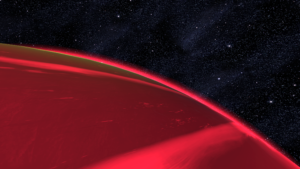
- Orbital Distance: N/A AU
- Orbital Period: 74.1 Earth-years
- Keplerian Ratio: N/A
- Radius: 72,820 km
- Day Length: 15.7 Earth-hours
- Atmospheric Pressure: N/A atm
- Surface Temp: N/A °C
- Surface Gravity: N/A g
- Mass: N/A Earth-masses
- Satellites: >120
Illapa is a hydrogen-helium gas giant with an unusual ruby color caused by contaminants in the atmosphere. The world has over 120 moons, one of the highest totals of all known systems.
Once full development of Chasca colony begins, a helium-3 refining infrastructure will be developed in the Illapa system, concentrated on the large ice moon of Coniraya.
–
Supay:

- Orbital Distance: N/A AU
- Orbital Period: 275.5 Earth-years
- Keplerian Ratio: N/A
- Radius: 4,317 km
- Day Length: 63.4 Earth-hours
- Atmospheric Pressure: 0.00 atm
- Surface Temp: −216 °C
- Surface Gravity: 0.25 g
- Mass: 0.114 Earth-masses
Supay has the composition of an ice dwarf planet, but is unusually large for such a body. It has a trace atmosphere of krypton and xenon. The frozen surface is dotted with deposits composed of potassium and light metals, brought to the surface by cryovolcanic processes.
Supay’s icy surface was often used as a source of potable water by passing merchant vessels. Since the Alliance claimed the inner system world of Chasca, satellites placed in orbit automatically bill any vessel landing on the world for the mass of water removed from the surface.
ExoGeni has had a difficult time keeping these satellites operational; they often meet with “accidents” caused by impact with jettisoned ship debris.
–
–
video

